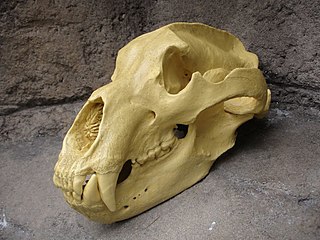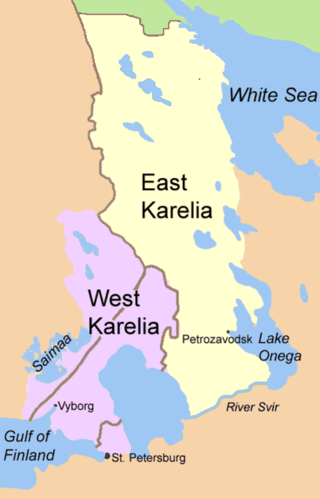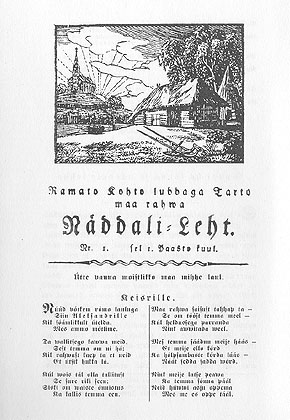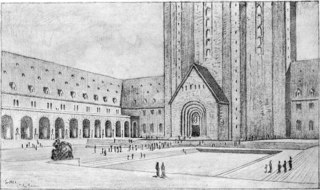
The Kalevala is a 19th-century compilation of epic poetry, compiled by Elias Lönnrot from Karelian and Finnish oral folklore and mythology, telling an epic story about the Creation of the Earth, describing the controversies and retaliatory voyages between the peoples of the land of Kalevala called Väinölä and the land of Pohjola and their various protagonists and antagonists, as well as the construction and robbery of the epic mythical wealth-making machine Sampo.
Finnish mythology commonly refers of the folklore of Finnish paganism, of which a modern revival is practiced by a small percentage of the Finnish people. It has many shared features with Estonian and other Finnic mythologies, but also with neighbouring Baltic, Slavic and, to a lesser extent, Norse mythologies.

In Finnish mythology, Otso is a bear, the sacred king of animals and leader of the forest. It was deeply feared and respected by old Finnish tribes. Otso appears in the Finnish national epic, the Kalevala. Due to the importance of the bear spirit in historical Finnish paganism, bears are still considered by many Finns to be kings of the forest, and the bear is even the national animal of Finland.

Väinämöinen is a demigod, hero and the central character in Finnish folklore and the main character in the national epic Kalevala by Elias Lönnrot. Väinämöinen was described as an old and wise man, and he possessed a potent, magical singing voice.

Karelians are a Baltic Finnic ethnic group who are indigenous to the historical region of Karelia, which is today split between Finland and Russia. Karelians living in Russian Karelia are considered a distinct ethnic group closely related to Finnish Karelians, who are considered a subset of Finns. This distinction historically arose from Karelia having been fought over and eventually split between Sweden and Novgorod, resulting in Karelians being under different cultural spheres.

East Karelia, also rendered as Eastern Karelia or Russian Karelia, is a name for the part of Karelia that since the Treaty of Stolbovo in 1617 has remained Eastern Orthodox and a part of Russia. It is separate from the western part of Karelia, called Finnish Karelia or historically Swedish Karelia. Most of East Karelia has become part of the Republic of Karelia within the Russian Federation. It consists mainly of the old historical regions of Viena Karjala and Aunus Karjala.

Karelia is an area in Northern Europe of historical significance for Russia, Finland, and Sweden. It is currently divided between northwestern Russia and Finland.

Kuhmo is a town and a municipality in Finland and is located at the south-eastern corner of the Kainuu region. The municipality has a population of 7,582 and covers an area of 5,456.78 square kilometres (2,106.87 sq mi) of which 649.97 km2 (250.95 sq mi) is water. The population density is 1.58 inhabitants per square kilometre (4.1/sq mi). It shares a border of 120 kilometres (75 mi) with Russia. Neighbouring towns are Hyrynsalmi, Lieksa, Nurmes, Ristijärvi, Sotkamo and Suomussalmi. A neighbour city across the Russian border is Kostomuksha. Vartius, one of the border crossing points between Finland and Russia, is located in northern Kuhmo.
Finnish poetry is the poetry from Finland. It is usually written in the Finnish language or Swedish language, but can also include poetry written in Northern Sámi or other Sámi languages. It has its roots in the early folk music of the area, and still has a thriving presence today.

Greater Finland, was an irredentist and nationalist idea that was a subset of Pan-Finnicism which emphasized the territorial expansion of Finland. The most common concept of Greater Finland saw the country as defined by natural borders encompassing the territories inhabited by Finns and Karelians, ranging from the White Sea to Lake Onega and along the Svir River and Neva River—or, more modestly, the Sestra River—to the Gulf of Finland. Some proponents also included the Torne Valley, Ingria, and Estonia.

Finnish literature refers to literature written in Finland. During the European early Middle Ages, the earliest text in a Finnic language is the unique thirteenth-century Birch bark letter no. 292 from Novgorod. The text was written in Cyrillic and represented a dialect of Finnic language spoken in Russian Olonets region. The earliest texts in Finland were written in Swedish or Latin during the Finnish Middle Age. Finnish-language literature was slowly developing from the 16th century onwards, after written Finnish was established by the Bishop and Finnish Lutheran reformer Mikael Agricola (1510–1557). He translated the New Testament into Finnish in 1548.

Larin Paraske was an Izhorian runic singer. She is considered a key figure in Finnish folk poetry and has been called the "Finnish Mnemosyne". Her frequent listeners included several romantic nationalist artists, such as Jean Sibelius, seeking inspiration from her interpretations of Kalevala, an epic poem compiled from Finnish folklore by Elias Lönnrot.
Kaleva – also known as Kalevi or Kalev – and his sons are important heroic figures in Estonian, Finnish and Karelian mythology. In the Finnish epic the Kalevala, he is an ancient Finnish ruler. In Estonian mythology and Friedrich Reinhold Kreutzwald's epic poem Kalevipoeg, King Kalev was the father of King Kalevipoeg and the husband of Linda.
The Talking Band is an American off-off-Broadway theatre company specializing in experimental theatre, based in New York City.

Estophilia refers to the ideas and activities of people not of Estonian descent who are sympathetic to, or interested in, Estonian language, Estonian literature or Estonian culture, the history of Estonia, and Estonia in general. Such people are known as Estophiles.

The Baltic Finnic peoples, often simply referred to as the Finnic peoples, are the peoples inhabiting the Baltic Sea region in Northern and Eastern Europe who speak Finnic languages. They include the Finns, Estonians, Karelians, Veps, Izhorians, Votes, and Livonians. In some cases the Kvens, Ingrians, Tornedalians and speakers of Meänkieli are considered separate from the Finns.

Nationalism was a central force in the history of Finland starting in the 19th century. The Finnish national awakening in the mid-19th century was the result of members of the Swedish-speaking upper classes deliberately choosing to promote Finnish culture and language as a means of nation building—i.e. to establish a feeling of unity between all people in Finland including between the ruling elite and the ruled peasantry. The publication in 1835 of the Finnish national epic, the Kalevala, a collection of traditional myths and legends which is the folklore common to the Finns and to the Karelian people, stirred the nationalism that later led to Finland's independence from Russia.
Kalevala Day, known as Finnish Culture Day by its other official name, is celebrated each 28 February in honor of the Finnish national epic, Kalevala. The day is one of the official flag flying days in Finland.

The Kalevala House was a planned huge building designed by Eliel Saarinen for the Kalevala Society in Helsinki, Finland in 1921, which was never built. It was to be built at the top of Munkkiniemi, close to the current Hotel Kalastajatorppa. The Kalevala House was to become not only the premises of the Kalevala Society, but also a center of Finnish culture: it would have included a Finnish cultural research institute, exhibition spaces, artists' workspaces and "research chambers". In addition, Finnish great men and Fennomen would have been buried in the crypt at the foot of the 80-meter-high main tower.
Karelians, also known as Finnish Karelians or Karelian Finns, are a subgroup of the Finnish people, traditionally living in Finnish Karelia. Karelians speak eastern dialects of the Finnish language: the South Karelian dialects are spoken in South Karelia, while the eastern Savonian dialects are spoken in North Karelia. The South Karelian dialects were spoken in the Karelian Isthmus prior to the Winter War. Karelians are traditionally Lutheran Christians, with an Orthodox Christian minority, belonging to either the Evangelical Lutheran Church of Finland or the Orthodox Church of Finland respectively.













